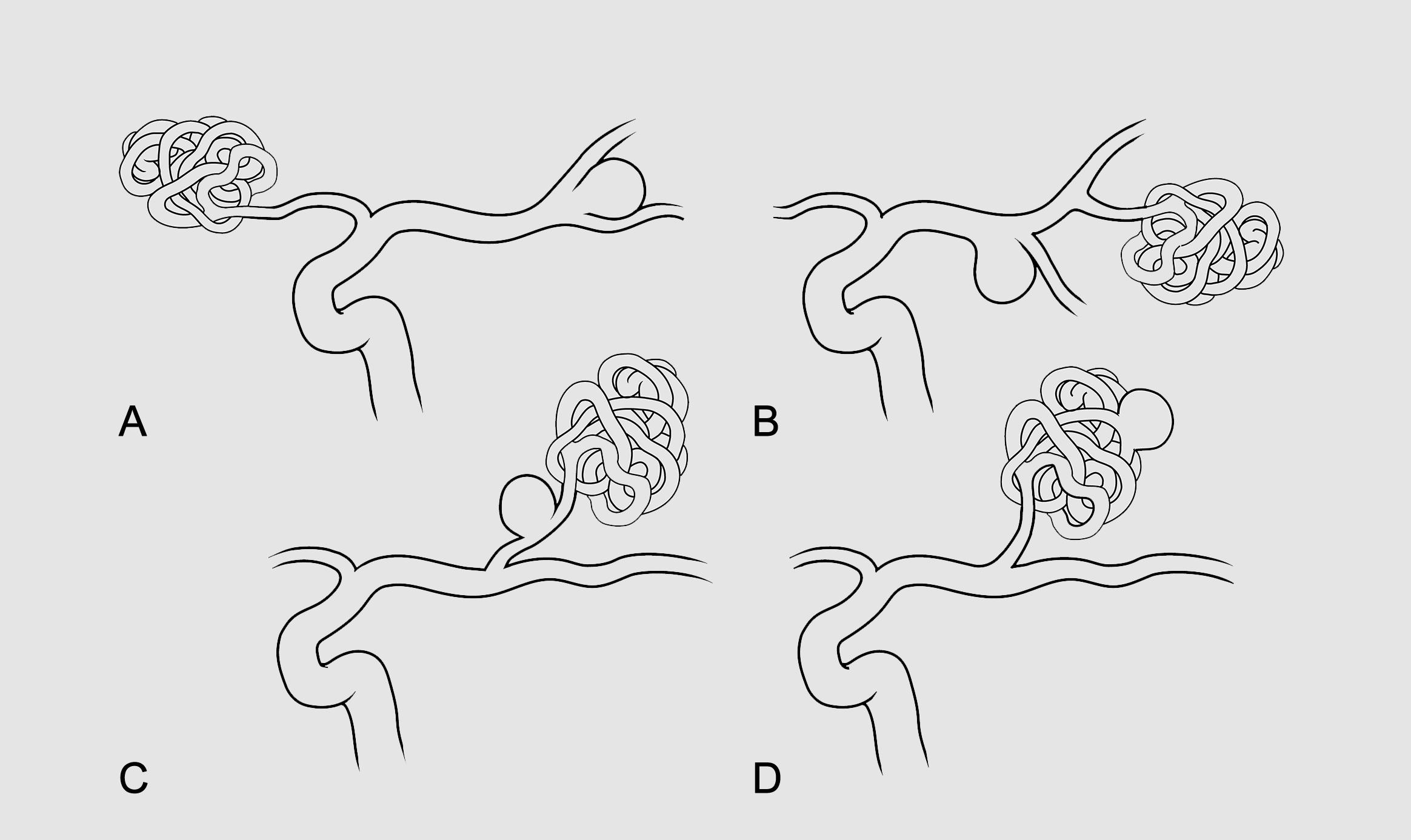Physical Address
304 North Cardinal St.
Dorchester Center, MA 02124
Aneurysms associated with iAVMs constitute a heterogeneous group with different risk profiles that must be taken into account when considering management options.
In cases of hemorrhagic presentation, determining the source of hemorrhage (i.e., aneurysm vs iAVM) is crucial.
Distal flow-related aneurysms and intranidal aneurysms increase the risk of hemorrhagic presentation.
Curability of the iAVM and accessibility and proximity of the aneurysm to the iAVM are critical to the decision-making process.
Prenidal and distal aneurysms have been reported to involute after elimination of the iAVM nidus.
Intracranial hemorrhage is the major cause of morbidity and mortality associated with intracranial arteriovenous malformations (iAVMs). The risk of hemorrhage depends on the iAVM morphology and the hemodynamics of any associated aneurysm as well as several other variables. Identifying and mitigating these risk factors is fundamental to the management of iAVMs. Aneurysms associated with iAVMs constitute a heterogeneous group of lesions, with each type having a different pathophysiology and risk profile. Hemorrhagic presentation, curability of the iAVM, accessibility and proximity of the aneurysm to the iAVM, and the potential rerupture risk are key factors to consider in the decision-making process.
Standardization of nomenclature is important for the interpretation of findings of related research, communication, and the development of decision algorithms. Unfortunately, none of the classifications of iAVM-associated aneurysms have received universal acceptance. The relationship of the aneurysm to iAVM flow is crucial to understanding the classification of iAVM-associated aneurysms, because aneurysms that are not located on the feeding arteries or major vessels giving rise to the feeding arteries are considered independent of or unrelated to the AVM. Therefore intracranial aneurysms in patients with iAVMs can be classified into two general categories: flow-related aneurysms and aneurysms that are unrelated to or remote from the iAVM nidus. This classification was proposed by Redekop et al. in 1987 and has been the most popular. Based on the topographic location and rupture risk, flow-related aneurysms are further classified into proximal (main intracranial vessel up to its primary bifurcation—i.e., internal carotid artery [ICA], basilar artery, M 1 segment of the middle cerebral artery [MCA], or A 1 segment of the anterior cerebral artery [ACA]—circle of Willis, including posterior communicating and anterior communicating arteries) or distal (located at midpoint or distally on a direct cerebral AVM feeder or distally to the proximal vessels). Intranidal aneurysms are considered venous. There is a controversy regarding postnidal venous aneurysms, and this term can actually be considered a misnomer, because these lesions do not have the wall structure of an arterial aneurysm and are better described as venous varices. Consequently, postnidal venous aneurysms are excluded from most classification systems. A schematic illustration of various types of these aneurysms is provided in Fig. 12.1 .

Understanding the natural history of iAVM-associated aneurysms is key to decision-making with respect to their management. The natural history of iAVM-associated aneurysms is based on the location and hemodynamic features of the aneurysm. Brown et al. reported hemorrhage rates as high as 7% per year at 5 years after diagnosis for patients with coexisting iAVMs and aneurysms, compared with a hemorrhage rate of 1.7% per year for patients with iAVMs alone. Adequate confirmation of the hemorrhage source was not possible in most patients with iAVMs and aneurysms, but those authors believed that the higher hemorrhage risk reflected rupture of coexisting aneurysms. More recently, the investigators of A Randomised Trial of Unruptured Brain Arteriovenous Malformations (ARUBA) reported a 16% incidence of associated aneurysms in the study cohort, with no correlation to hemorrhage at presentation or at follow-up completed on their initial data analysis.
In a large case series (526 cases) presented by Hung et al., 69 iAVMs were reported to have flow-related aneurysms. Patients with AVM-associated flow-related aneurysms were older in age ( P = .005). Aneurysms were also more commonly associated with AVMs involving the cerebellar vermis and cerebellar hemispheres ( P = .023 and .001, respectively). AVM patients presenting with subarachnoid hemorrhage were more likely to have an associated aneurysm ( P < .001). In that study most aneurysms were untreated (69.5%), and only 8 (9.8%) presented with rupture. At follow-up (mean, 5.3 years), patients with flow-related aneurysms were less likely to develop seizures ( P = .004). The annual risk of AVM hemorrhage was 1.33% for AVM-only patients and 1.05% for patients with iAVMs and flow-related aneurysms ( P = .248).
The investigators of several studies have tried to identify clinically significant risk factors associated with increased risk of hemorrhage of iAVMs. Marks et al. identified intranidal aneurysms as one of three angiographic characteristics that correlated positively with iAVM hemorrhage. Other associated factors included central venous drainage and periventricular or intraventricular location of the AVM. A subsequent study by the same group demonstrated a history of hemorrhage in all patients with an intranidal aneurysm diagnosed by catheter angiography. The results reported by Redekop et al. supported these findings, as hemorrhagic presentation was significantly more common in patients with AVM-associated intranidal aneurysms (72%) compared to those with aneurysms alone. The risk of rupture in patients with intranidal aneurysms in their study was 9.8% per year, which is considerably higher than the generally reported per-year risk rate of 2%–4% in the overall population of patients with iAVMs. Other risk factors for iAVM rupture include hemorrhagic presentation, prenidal aneurysms, and deep venous drainage.
Become a Clinical Tree membership for Full access and enjoy Unlimited articles
If you are a member. Log in here